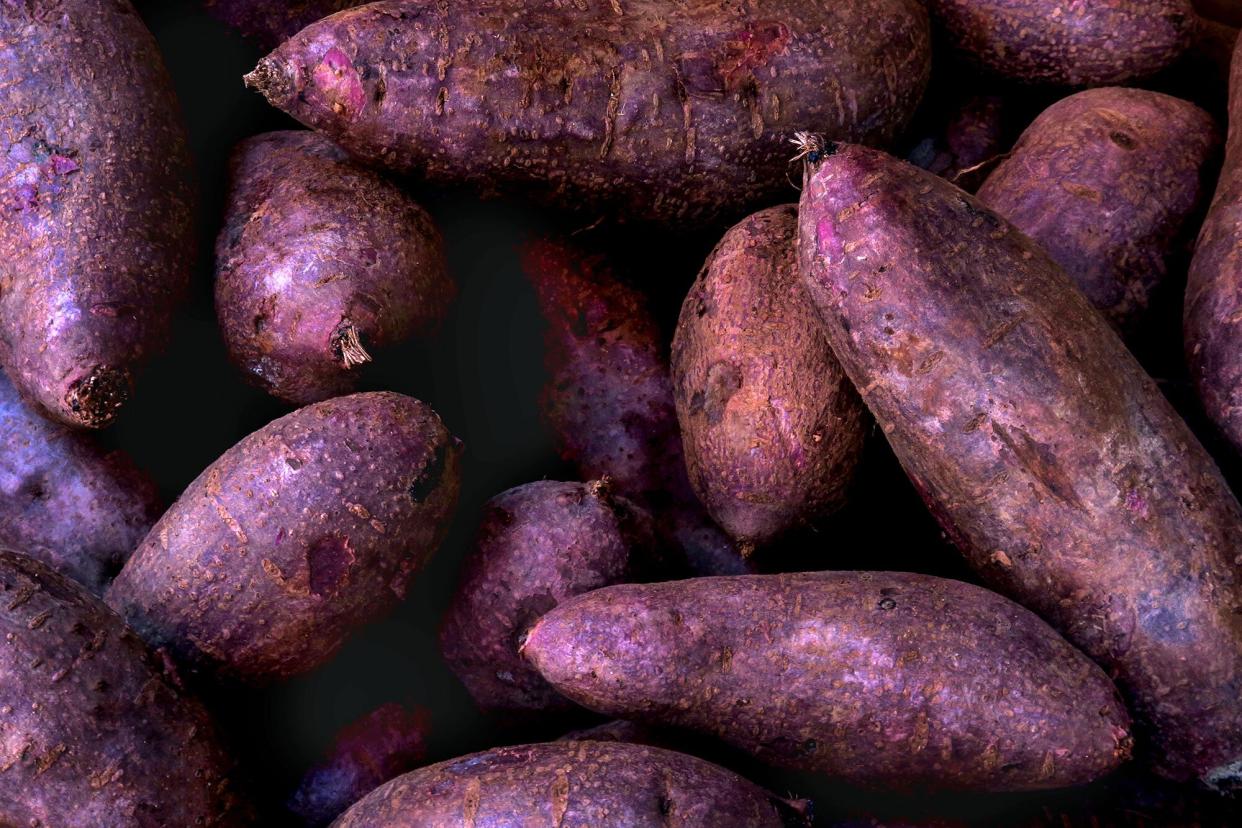Get to Know Ube

Getty Images
Ube is a purple yam native to Southeast Asia whose glimmering purple center, mild, sweet flavor, and coconut-like aroma have made it a popular ingredient in traditional Filipino sweets. Across the U.S., chefs are using ube to give color and character to everything from ube cocktails to ube cakes and even ube hamburger buns.
Ube is a major vegetable crop in the Philippines. The word ube (pronounced "ooo-bay") comes from the yam's name in Tagalog, the national language of the Philippines. (In the Philippines, it is also called ubi; when sold in seed catalogs in the United States for growing at home it is sometimes called "winged yam"). Ube is not to be confused with a purple sweet potato. Although purple sweet potatoes and ube share a rich purple color, they are entirely different ingredients. One of the most striking differences between the two is their appearance. Fresh ube has a dark, bark-like skin and flesh that can vary in color from a creamy white to a deep lavender. Purple sweet potatoes have a more smooth purple-colored skin and lilac-colored flesh. Anthocyanins, which are powerful antioxidants, are responsible for the purple color of both ingredients. Even though ube and purple sweet potatoes share a sweet, earthy taste, ube has a distinctively nuttier, vanilla-like flavor. In addition to their differences in taste, ube is more moist than sweet potatoes, which tend to be drier in texture. Apart from its beautiful color and delicious taste, ube also contains vitamins A and C, as well as high levels of potassium.
In the tropics, ube can be planted at any time of the year, but here in the United States, it's grown as an annual. The crop is low-maintenance, but can be difficult to contain. It is reported that vines can grow as tall as 30 feet, often climbing nearby walls and trees.
Preparing and Cooking
Fresh ube is often prepared and cooked like a potato — heated until it is soft. Like white potatoes, ube contains some toxins when raw, so it should always be thoroughly cooked. It can be prepared in a variety of ways: boiled, baked, mashed, or fried.
Storing
If you are able to source ube in fresh form, you should not store the whole ube in the refrigerator, as you would other starchy vegetables. Store them somewhere dry, dark and cool. The best way to preserve cooked ube is to cover it tightly in cling wrap or keep it in an airtight container to keep it from drying out. When stored this way, ube can last up to three days in the refrigerator and up to one month in the freezer. Keep dried or powdered ube in a cool dry place, away from sunlight.
Where to Purchase
As ube becomes more popular in American diets, it is important to consider its origins as a staple of Filipino culture for the past 400 years. Next time you look to enjoy the bright and beautiful goodness that comes from Ube, try to also support Filipino businesses—see some of our recommendations for where to source ube products below, as well as chef Nicole Ponseca's Where to Eat Delicious Filipino Food in Every State.
Fresh Ube
Ube is rarely imported as a fresh tuber in North America, but can sometimes be found fresh in the produce sections of Asian grocery stores. If you are lucky enough to find fresh ube, it can be eaten as a snack when boiled and skinned, or mashed then frozen to save for later.
Frozen Ube
Look in the freezer cases of Asian grocery stores for packages of frozen ube; it's usually mashed or grated, and already cooked so it can be used straight out of the package.
Ube Powder
Made from cooked, mashed, dehydrated, and ground ube, ube powder (also known as purple yam powder) must be cooked with water to reconstitute it into a paste, which can then be mixed into smoothies, added to white hot chocolate, incorporated into ice cream, or added to bread or pasta doughs to add color and a subtle nutty flavor. (Giron Powdered Yam; $5.19, sayweee.com)
Ube Extract
Made from ube steeped in alcohol, a few drops of ube extract adds a deep purple color and sweetness to recipes like this Halo-Halo Cocktail and these ube buns. (McCormick Ube Flavor Extract; $3.99 from sarapnow.com)
Ube Halaya
A thick, sweet pudding made from boiled and mashed purple yam mixed with sugar, butter, and coconut milk, ube jam is an element of many Filipino desserts such as halo-halo, but it's also deliciously decadent on its own. (Dragonfly Ube Halaya Purple Yam Jam; $5.99, sayweee.com)
Ube Ice Cream
Ube ice cream is another one of the main ingredients in the famous Filipino dessert, halo-halo, and it's also amazing on its own or atop your favorite warm pie. (Selecta Ube Royale Purple Yam Ice Cream; $4.88, selectaphilippines.com)

